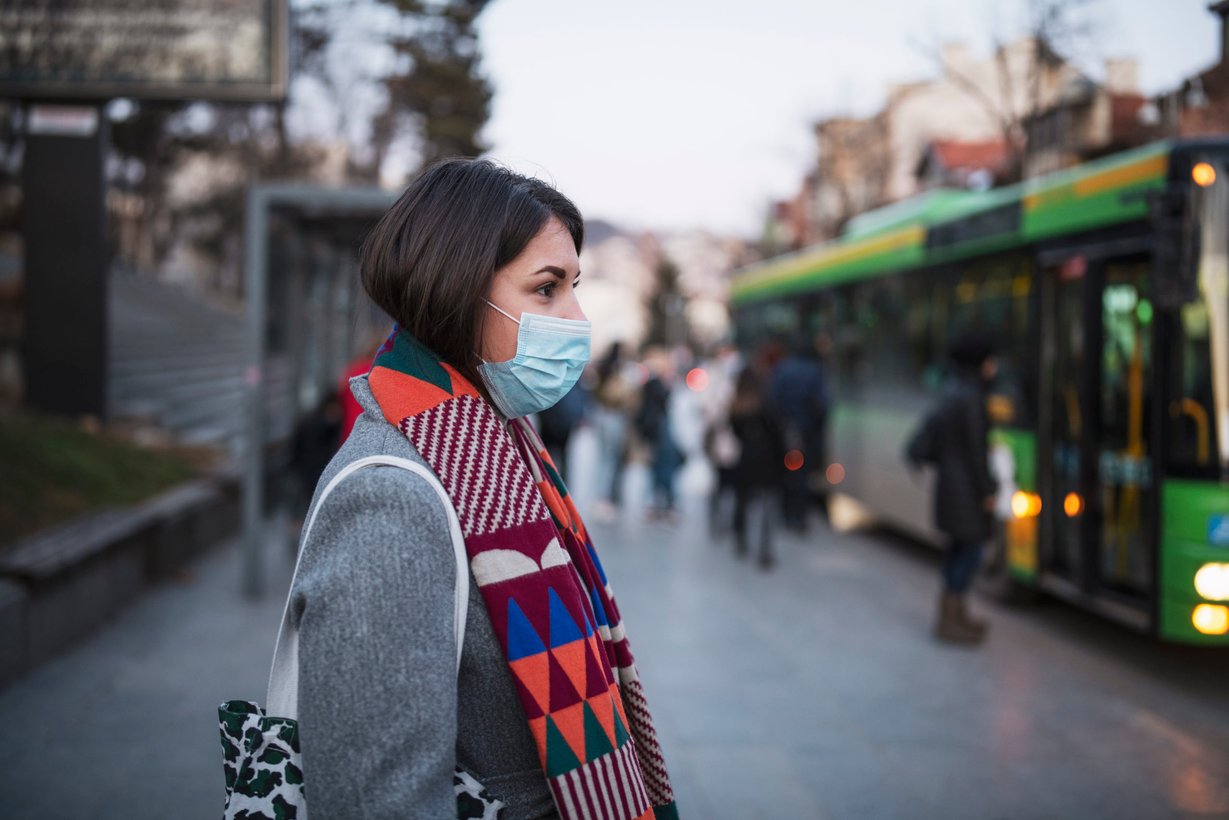The COVID-19 pandemic has already dramatically changed the public transport landscape in the UK. Spurred by government leaders’ warnings to stay off public transport “if you can,” UK residents have broadly complied. Overall mobility is down to 1955 levels, and journeys in shared transport have fallen precipitously.
Transport for London reported in May that Tube journeys were down by 95% and bus journeys by 85% compared to last year, even though buses are now free for riders. Bus ridership was even lower outside London, with volumes down roughly 90% from normal levels.
While the nation is starting to re-awaken, we can’t yet snap back to our old “normal.” The coronavirus is still present in the UK and globally, and there is a serious risk of a second wave without ongoing steps to contain its spread. Further, citizens now fear that shared spaces and crowded places will bring illness into their homes.
The government has devoted billions of pounds toward measures to ease transport system strain and encourage citizens to start moving again in a cleaner, more active way than before. We’ve seen investment in cycling and walking, and massive encouragement of home-working for the foreseeable future. However, without a concerted, focused effort on rebuilding public transport for the post-COVID future, people may continue to stay away from buses, trains, and other shared mobility. Indeed, a May 2020 survey found that three in five Britons would be uncomfortable using public transport after lockdown restrictions end, unless new measures are put in place.
Habits are hard to break, and there’s a risk that people will continue to stay off public transport once the immediate threat is overcome, especially if they invest in private vehicles as a result of this crisis. This could eventually lead to a reduction in services and a loss of public transport options for those who most need them, and to a massive growth in private car use, exacerbating the pollution, congestion, and climate issues that already plagued the nation before COVID-19.
This is especially concerning because of the critical role public transport plays in providing economic mobility and opportunity for individuals who are unable to purchase or drive private cars. Studies have shown that people without reliable and affordable transportation have diminished employment options, weaker access to educational opportunities, and more difficulty accessing healthcare and other services because they cannot consistently or conveniently travel to work, classes, and other appointments on time. The UK government, councils, operators, and transport authorities can take the following steps to rebuild trust in public transport during the COVID recovery to preserve shared, sustainable, and safe mobility. These steps aren’t intended to be exhaustive, as much more will need to be done to fully reopen public transport systems, but they are an important first start to rebuilding our society and economy.

1. Build confidence in social distancing by limiting vehicle capacity, at least for the short term.
In the pre-COVID world, transport operators were considered successful when they could get “bums in seats” — and bodies generally packed together as closely as possible — to maximise the efficiency of each run. Today, the sight of a packed train carriage or bus is rare (and generally limited only to London), but is likely a source of enough fear and media sensation to turn people away from public transport at all.
Operators and transport authorities now need to take a new approach that prioritises distance between riders, and ensures that riders can plan a bus or train journey knowing that they’ll be able to stay sufficiently distanced from other riders. They can do this by requiring passengers to book their spaces on each bus or train in advance using mobile app technology — even when that bus or train follows a pre-set route — and ensuring that no vehicle is booked beyond a safe capacity allowing for social distancing. When riders know that they won’t be faced with a bus packed with other commuters ‘cheek to jowl,’ they’ll feel more comfortable continuing to rely on public transport.

2. Prevent crowding at stations and bus stops through pre-booking and pre-planning.
In the eyes of the passenger, public transport is not just about the time spent in a bus or a train carriage. The moments spent leaving home and arriving at one’s destination are an equally integral part of the experience. If bus stops and train stations suddenly become synonymous with long queues to account for social distancing, people will likely grow frustrated by the additional waiting time and apprehensive about potential exposure.
Dynamic, demand-responsive transport systems with flexible networks can help to address this challenge. When booking a seat on a DRT bus, passengers can enjoy the peace of mind that the vehicle will never be overcrowded. Additionally, the added benefit of using “virtual bus stops” that pick up and drop off passengers dynamically across the community is that the bus can often avoid busy stations and stops altogether.
Preventing overcrowding in fixed-route services will require thinking about the transport network as an integrated, multi-modal system with many stakeholders, and encouraging pre-planning of journeys. As an immediate step, operators can require passengers to pre-book seats in buses and other transport modes at specific times, which will discourage passengers from waiting at stations and creating crowds.
Integrated ticketing that links bus, train, tram, and active travel options can also help, especially if it can encourage passengers to avoid the most congested areas. For example, authorities could adjust pricing to incentivise riders to use less utilised bus routes or to avoid interchanges at the busiest stations.
All of this will require a new mindset around transport, including participation from employers, schools, and other stakeholders. Work start and end times will likely need to be staggered to enable staff to come in during less busy periods, and riders will need to prepare for each journey in advance and may need to consider longer routes to avoid contributing to crowds.

3. Embrace technology and data for contract tracing.
Public health leaders have indicated that the UK can only reopen its economy safely when a test, track, and trace system is fully in place to help limit the spread of the coronavirus. Progress is being made to hire and train contact tracers and to develop technology to alert individuals if they’ve been in close physical proximity to someone who later tests positive for COVID-19. Digital, technologically-enhanced transport booking systems can help. If people use a mobile app or online system to book a specific bus or train, transport operators will be able to see which drivers and passengers traveled together in order to support retroactive contact-tracing and to communicate with individuals who may have been exposed to the virus.
The most effective systems for tracking and tracing the spread will integrate multiple sources of information, including details on transport bookings, and not just on individuals’ recollections of their past interactions or smartphone-based tracking systems that will only reach a fraction of the population. These systems will also need to address citizens’ concerns on data privacy and security, and should ensure that all passengers understand how their personal information will be monitored and protected as part of the public health effort.

4. Reorganise bus interiors to force social distancing and encourage passenger hygiene.
Vehicles will need to look and feel different to protect riders and build confidence in their safety, in order to get passengers comfortable with public transport again. While the exact vehicle configurations and the ability to retrofit will vary across individual operators and communities, it will generally be important to force social distancing and encourage passenger hygiene.
Where feasible, operators can install Perspex screens between seats and around the driver cabin to act as ‘sneeze guards’ preventing disease spread. Open windows and air filtration systems can further prevent spread and build passenger confidence. Drivers and passengers can be encouraged to wear masks or face coverings while on board. Hand sanitiser or washing stations should be present in all transport hubs and on vehicles where possible, and should be made visible to riders with signage and advertising. Lastly, riders should be frequently and visibly encouraged to contribute to the safety of their community by staying away from public transport if they are experiencing any symptoms of the virus.

5. Eliminate cash and ticket handover on board (while finding solutions for passengers without mobile payment options).
The COVID-19 pandemic has spurred a growth in contactless and digitalised payment systems as shopkeepers and citizens try to avoid touching currency that’s been passed from hand-to-hand, and to cut down on physical contact between customers and vendors for payment. Many public transport providers, including Transport for London, have temporarily foregone bus fares altogether to minimise contact between bus drivers and riders.
Even as cities and communities start to reopen, they can continue to eliminate cash and ticket payments in order to avoid putting drivers and passengers at unnecessary risk. Operators and authorities can accommodate those without digital payment methods by creating individual passenger accounts that can accept direct bank deposits or safe, socially-distant cash deposits in advance of each ride. Operators who move to digital ticketing may also find this improves their operating costs, safety, and efficiency more broadly. Some agencies have entire teams focused on processing, counting, and transporting cash and tickets, and these roles can be refocused on other tasks when payment is digitalised. Even importantly, individual drivers can easily accumulate enough cash over the course of a day to invite theft and violence, a risk that can be eliminated in full with digital payments.

6. Safeguard the health of employees.
Bus drivers and other public transport employees have been on the front lines of the COVID-19 response, and often put their own health at risk to continue transporting other essential workers through the crisis. Authorities have a responsibility to reassure employees about safety and make structural changes to ensure they can stay healthy and well as transport expands.
'The exact steps each operator will need to take will vary across communities, but key components include sufficient personal-protective equipment, frequent COVID-19 testing once available, temperature checks before shifts, and generous sick leave policies to ensure drivers do not come to work when they are ill. This is crucial to maintain operations — if the virus spreads through a depot, it will be much harder to maintain service levels — and to build passengers' confidence that they will not come into contact with ‘super spreaders’ when they get into a bus or train.

7. Enforce relentless cleaning processes, and make them visible.
Public transport users have been inundated with media reports about how long the coronavirus can survive on plastic and metal surfaces and how easy it is to become infected from touching contaminated surfaces. Operators can overcome the fear associated with buses and train carriages by implementing stringent cleaning procedures — including vehicle fogging and disinfecting of high-touch surfaces — and making sure these are visible to passengers. Operators can build trust that overnight cleaning is actually happening by posting signs documenting cleaning frequency in vehicles and using social media and other tools to highlight new processes.
Over the coming weeks and months, cities, councils, transport authorities, and operators will be faced with a complex reopening, coupled with the continued fear of a second wave of infections. As we chart this new course, it will be crucial to focus on building resilient public transport systems that reinforce public trust and help continue to make progress toward a sustainable and safe future.




